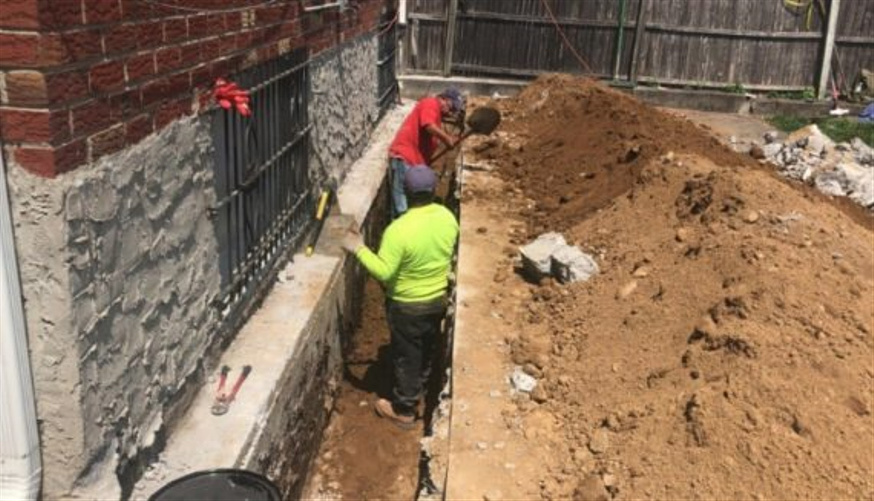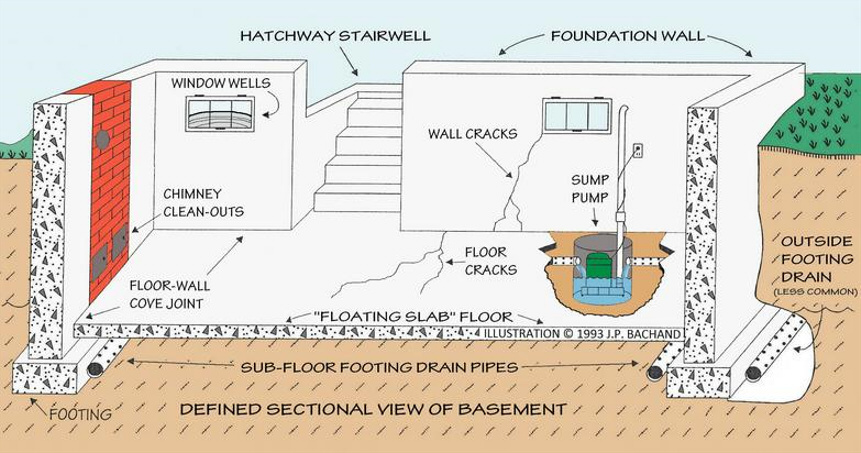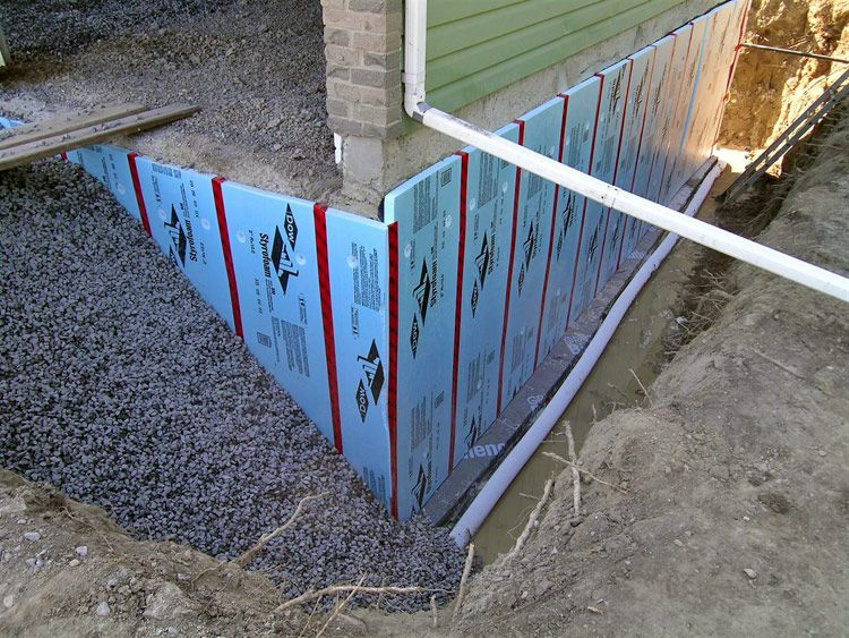Tel. (647) 800-1239
Complete basement waterproofing Mississauga Ontario.

Tel. (647) 800-1239 free basement waterproofing quote in Mississauga.


Basements are one of the most important parts of a Mississauga home and yet it is often the most neglected. This can be due to the problems attached with having a ((basement)) especially because it is susceptible to water leaks and build up of moisture. Due to this fact, a wet or damp basement can easily become a flooded basement . In addition to this, it can lead to other more complicated problems such as unstable foundations. To prevent these from happening, it is important that waterproofing be done. Homepros basement waterproofing in Mississauga On., can address the water leaks and waterproof the basement so as to ensure it stays dry at all times. Basement waterproofing involves the techniques and materials being used to prevent water from penetrating the basement of a house or a building. It requires more than simply patching up troubled spots found in a building. Our other common basement waterproofing methods include: Exterior Basement Waterproofing This method is usually applied by basement waterproofing contractors during the construction of the building. This method is designed to stop water from causing any form of damage to the building. Exterior basement waterproofing uses polymers and membranes to coat the exterior of the basement walls. Although this method is superb for homes under construction, it is not recommended for already existing homes. Interior Water Drainage This is one of the most effective waterproofing solutions. The installation of water drainage system will help prevent the buildup of water. This basement drainage system moves the water away from the footers of the foundation and out below the floor of the basement.
Wet basement waterproofing Mississauga Ontario. Call us free estimate, quote.


Mississauga Ontario is a Canadian city in the province of Ontario. Situated on the northwestern shore of Lake Ontario in the Regional Municipality of Peel, it borders Toronto (Etobicoke) to the east, Brampton to the north, Milton to the northwest, and Oakville to the southwest. Mississauga is the seventh-most populous municipality in Canada, third-most in Ontario, and second-most in the Greater Toronto Area (GTA) after Toronto itself. However, for the first time in its history, the city's population declined according to the 2021 census. The growth of Mississauga was initially attributed to its proximity to Toronto. However, during the latter half of the 20th century, the city attracted a diverse and multicultural population. Over time, it built up a thriving, transit-oriented central business district of its own; the Mississauga City Centre. Malton, a neighbourhood of the city located in its northeast end, is home to Toronto Pearson International Airport, Canada's busiest airport, as well as the headquarters of many Canadian and multinational corporations. Mississauga is not a traditional city, but is instead an amalgamation of three former villages, two townships, and a number of rural hamlets (a general pattern common to several suburban GTA cities) that were significant population centres, with none being clearly dominant, prior to the city's incorporation that later coalesced into a single urban area. Indigenous people have lived in the area for thousands of years and Mississauga is situated on the traditional territory of the Wendat, Haudenosaunee and Anishinaabeg people, including the namesake Mississaugas. Most of present-day Mississauga was founded in 1805 as Toronto Township within York County, and became part of Peel County when new counties were formed by splitting off parts of the original county in 1851. Mississauga itself was established in 1968 as a town, and was reincorporated as a city in 1974, when Peel was restructured into a regional municipality. Etymology The name Mississauga comes from the Anishinaabe word Misi-zaagiing, meaning '[those at the] Great River-mouth'. Other forms such as Sauga and, in reference to the city's residents, Saugans,[12] and Mississaugans, are also commonly used. History See also: List of historic places in Mississauga Palaeo-Indigenous period (9000–8500 BCE) A single site in Mississauga with Hi-Lo projectile points was registered in the Ontario Ministry of Culture database of archaeological sites. Lake Ontario was much smaller at this time, and sites from this period may be 500 m into the lake. According to Smith, there was a growing population at this time. There are 23 known Archaic sites in Mississauga, mostly in the Credit River and Cooksville Creek drainage systems. People would congregate at rapids and the mouths of these rivers to catch fish during spawning runs. They would harvest nuts and wild rice at the wetland margins in the late summer. During late Archaic times, there were large cemeteries. Pottery first appears during this period in the style of the Point Peninsula complex, and near the end of the Woodland period, the first semi-permanent villages appear. Artifacts show that these people engaged in long-distance trade, likely as part of the Hopewell tradition. Toronto Township, consisting of most of present-day Mississauga, was formed on 2 August 1805 when officials from York (what is now the City of Toronto) purchased 85,000 acres of land from the Mississaugas under Treaty 14. A second treaty was signed in 1818 that surrendered 2,622 km2 of Mississauga land to the British Crown. and Treaty 23. Founding of Settlements Mississauga's original villages (and some later incorporated towns) settled included Clarkson, Cooksville, Dixie, Erindale (called Springfield until 1890), Lakeview, Lorne Park, Port Credit, Sheridan, and Summerville. The region became known as Toronto Township. Part of northeast Mississauga, including the Airport lands and Malton were a part of Toronto Gore Township. After the land was surveyed, the Crown gave much of it in the form of land grants to United Empire Loyalists who emigrated from the Thirteen Colonies during and after the American Revolution, as well as loyalists from New Brunswick. A group of settlers from New York State arrived in the 1830s. The government wanted to compensate the Loyalists for property lost in the colonies and encourage development of what was considered frontier. In 1820, the government purchased additional land from the Mississaugas. Additional settlements were established, including: Barbertown, Britannia, Burnhamthorpe, Churchville, Derry West, Elmbank, Malton, Meadowvale (Village), Mount Charles, and Streetsville. European-Canadian settlement led to the eventual displacement of the Mississaugas. In 1847, the government relocated them to a reserve in the Grand River Valley, near present-day Hagersville. Pre-confederation, the Township of Toronto was formed as a local government; settlements within were not legal villages until much later. Suburban growth and the creation of Mississauga Except for small villages and some gristmills and brickworks served by railway lines, most of present-day Mississauga was agricultural land, including fruit orchards, through much of the 19th and first half of the 20th century. In the 1920s, cottages were constructed along the shores of Lake Ontario as weekend getaway homes for Torontonians. The Queen Elizabeth Way (QEW) highway, one of the first controlled-access highways in the world, opened from Highway 27 to Highway 10 (Hurontario Street) in Port Credit, in 1935 and later expanded to Hamilton and Niagara in 1939. In 1937, 1,410.8 acres of land was sold to build Malton Airport (which later became Pearson Airport). It became Canada's busiest airport which later put the end to the community of Elmbank. The first prototypical suburban growth of Toronto Township began after World War II, Applewood Acres was the first major planned development near the QEW and Dixie Road, and urbanization soon rapidly expanded north and west. In 1952, Toronto Township annexed the southern portion of Toronto Gore Township. Two large new towns; Erin Mills and (New) Meadowvale, were started in 1968 and 1969, respectively. Most of Mississauga was built out by 2005. The areas amalgamated to create the present city: The Town of Mississauga (red), was created out of Toronto Township, which in 1952 annexed a portion of Toronto Gore Township (right of dashed white line). In 1968 (the year of its incorporation), the police village of Malton (white outline) was absorbed into it. The town became a city in 1974, and absorbed Port Credit, Streetsville, and a portion of Oakville (beige), but ceded the northern extremity (separated section of red at top) to Brampton. A final annexation occurred in 2010, when a thin strip of land was purchased from Milton (blue) to bring the city limits to Highway 407. While the Township had many settlements within it, none of them (save for the larger enclave communities of Port Credit and Streetsville) were incorporated, and all residents were represented by a singular Township council (Malton had special status as a police village, allowing it partial autonomy). To reflect the community's shift away from rural to urban, council desired conversion into a town, and in 1965 a call for public input on naming it received thousands of letters offering hundreds of different suggestions. "Mississauga" was chosen by plebiscite over "Sheridan" by a vote of 11,796 to 4,331, and in 1968 the reincorporation went forward, absorbing Malton in the process. Port Credit and Streetsville remained separate, uninterested in ceding their autonomy or being taxed to the needs of a growing municipality. Political will, as well as a belief that a larger city would be a hegemony in Peel County, kept them as independent enclaves within the Town of Mississauga, but both were amalgamated into Mississauga when it reincorporated as a city in 1974. At this time, Mississauga annexed lands west of Winston Churchill Boulevard from Oakville in the northwest, in exchange for lands in the northernmost extremity (which included Churchville) south of Steeles Avenue which were transferred to Brampton. That year, Square One Shopping Centre opened; it has since expanded several times. On 10 November 1979, a 106-car freight train derailed on the CP rail line while carrying explosive and poisonous chemicals just north of the intersection of Mavis Road and Dundas Street. One of the tank cars carrying propane exploded, and since other tank cars were carrying chlorine, the decision was made to evacuate nearby residents. With the possibility of a deadly cloud of chlorine gas spreading through Mississauga, 218,000 people were evacuated. Residents were allowed to return home once the site was deemed safe. At the time, it was the largest peacetime evacuation in North American history. Due to the speed and efficiency with which it was conducted, many cities later studied and modelled their own emergency plans after Mississauga's. For many years afterwards, the name "Mississauga" was, for Canadians, associated with a major rail disaster. North American telephone customers placing calls to Mississauga (and other post-1970 Ontario cities) may not recognise the charge details on their bills. The area's incumbent local exchange carrier, Bell Canada, continues to split the city into five historical rate centres–Clarkson, Cooksville, Malton, Port Credit, and Streetsville. However, they are combined as a single Mississauga listing in the phone book. The first Touch-Tone telephones in Canada were introduced in Malton on 15 June 1964. On 1 January 2010, Mississauga bought land from the Town of Milton and expanded its border by 400 acres (1.6 km2), to Highway 407, affecting 25 residents. Also in January 2010, the Mississaugas and the federal government settled a land claim, in which the band of indigenous people received $145,000,000, as just compensation for their land and lost income. Geography Main article: Geography of Mississauga The Credit River The Skyline of Mississauga, seen from Hurontario Street @ Highway 403. Mississauga covers 288.42 square kilometres (111.36 sq mi) of land, fronting 13 kilometres (8.1 mi) of shoreline on Lake Ontario. Mississauga is bounded by Oakville and Milton to the west/southwest, Brampton to the north, Toronto to the east, and Lake Ontario to the south/south-east. Halton Hills borders Mississauga's north-west corner. With the exception of the southeast border with Toronto (Etobicoke Creek), Mississauga shares a land border with all previously mentioned municipalities. Two major river valleys feed into the lake. The Credit River is by far the longest with the heaviest flow, it divides the western side of Mississauga from the central/eastern portions and enters the lake at the Port Credit harbour. The indented, mostly forested valley was inhabited by first nation peoples long before European exploration of the area. The valley is protected and maintained by the Credit Valley Conservation Authority (CVCA). Etobicoke Creek forms part of the eastern border of Mississauga with the city of Toronto. North of there it passes through the western limits of Pearson Airport. There have been two aviation accidents, in 1978 and 2005 where aircraft overshot the runway and slid into the Etobicoke creek banks. In 1954, heavy flooding resulted in some homes along the riverbank being swept into the lake after heavy rains from Hurricane Hazel. Since that storm, houses are no longer constructed along the floodplain. The creek and its tributaries are administered by the Toronto and Region Conservation Authority (TRCA). Most land in Mississauga drains to either of the two main river systems, with the exception of the smaller Mary Fix and Cooksville Creeks which run roughly through the centre of Mississauga entering the lake near Port Credit. Some small streams and reservoirs are part of the Sixteen Mile Creek system in the far north-west corner of the city, but these drain toward the lake in neighbouring Milton and Oakville. The shoreline of former Glacial Lake Iroquois roughly follows the Dundas Street alignment, although it is not noticeable in some places but is more prominent in others, such as the site of the former brickyard (Shoreline Dr. near Mavis Rd.), the ancient shoreline promenteau affords a clear view of downtown Toronto and Lake Ontario on clear days. The land in Mississauga in ranges from a maximum elevation of 214 m (699 ft) ASL in the far western corner, near the Hwy. 407/401 junction, to a minimum elevation at the Lake Ontario shore of 76 m (249 ft) above sea level. Apart from the embankments of Credit River valley, it tributaries and the Iroquois shoreline, the only noticeable hills in Mississauga are actually part of the former Britannia Landfill, now a golf course on Terry Fox Way. On August 17, 2024, heavy rainfalls caused localized flooding in areas across the city. The floods caused many traffic disruptions as well as dangerous road conditions and road closures. All creeks and rivers throughout Mississauga were either at full capacity or flooded into parks and greenspaces. Neighbourhoods/areas Absolute World, condominiums in the City Centre.